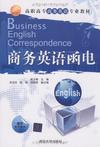商务英语函电
出版时间:2009-11 出版社:清华大学出版社 作者:房玉靖 编 页数:274
前言
随着经济全球化进程的不断加速,中国在国际经济中的地位日益提高,与世界各国间的经济、贸易活动愈加频繁,对外经济贸易事业得到了空前的发展。面对这一形势,我国将需要越来越多既懂经济贸易又精通专业英语的复合型人才。因此,我们编写了《商务英语函电》,以适应高职高专人才培养目标对外经贸人才的需求。 本书遵循实用性、可操作性的原则,结合外经贸工作的行业特点和专业英语学习的需要,在选材上注重前瞻性,着眼于行业新理念、新方法、新术语的导入,在编写内容上注重系统性、科学性及广泛性。各个单元的独特设计使不同程度的学习者都能学有所获。书中涵盖国际贸易实际操作中各个环节的信函写作,力求教学内容与外经贸行业的职业能力要求相一致,与职业标准相衔接。在内容安排上,突出了“能力培养”和“创新教育”,除了系统的知识介绍外,加入了大量的常用专业术语和功能性句型,同时加大了技能训练的比重。通过学习和实训,有助于学生掌握各类外经贸信函的基本内容及写作技巧,能独立运用商务信函的词汇及固定句型,熟练撰写函件。本教材采用模块教学,按照实际工作流程,共分16个模块,首先简要介绍外贸信函和电子邮件的基本要素、格式和写作技巧,然后针对外经贸进出口流程的主要环节进行介绍,包括建立业务关系、资信查询、促销、询盘、报价、发盘与还盘、接受与订货、支付、包装、装运、成交、保险、索赔与理赔及代理等内容。 每个教学模块包括:学习目标、背景知识介绍、写作技巧、信函实例、注释、贸易术语、功能句型及课后练习,其中练习由基础训练和拓展训练两部分组成,使学生能够在巩固基本语言运用和表达的基础上进行信函翻译和撰写,循序渐进地掌握各类商务信函的写作技能,培养并提高学生使用专业英语进行交际的实际能力,本书最后的总复习部分附有大量的基础题练习,供学生进行基本功训练。 本教材作为“全国高职高专专业外语规划教材”之一,是适用于高职高专商务英语、国际贸易、国际商务等专业学生使用的专业英语教材,也可供从事外经贸和国际商务工作的人员参考使用。 本书无论从体例安排到内容设置,从知识点的归纳到教法的运用,都进行了大胆探索和尝试,欲为外经贸高等职业教育教材的编写与探索尽微薄之力。本教材的编写人员既有多年从事商务英语教学从而积累了丰富教学资源的教授,也有来自企业一线从事外经贸工作的双师型教师。本教材由房玉靖担任主编,编写人员有房玉靖、刘玉玲、张怡和刘晓丽。同时,何瑞斌对本教材的编写提供了大量较新的实际业务素材,在此表示衷心的感谢。由于时间和水平有限,疏漏和不足在所难免,希望广大教师、读者及专家学者多提宝贵意见,以便日后充实与完善。
内容概要
本书遵循实用性和可操作性的原则,结合外经贸工作的行业特点和专业英语学习的需要,在选材上注重前瞻性,着眼于行业新理念、新方法、新术语的导入,在编写内容上注重系统性、科学性和广泛性,兼顾不同程度的读者精心设计各模块,涵盖国际贸易实际操作中各个环节的信函写作,力求教学内容与外经贸行业的职业能力要求相一致,与职业标准相衔接。 全书采用模块教学,包含16个模块,首先简要介绍外贸信函和电子邮件的基本要素、格式和写作技巧,然后针对外经贸进出口流程的主要环节逐一呈现知识点和相关实例与实训。本书适用于高职高专商务英语、国际贸易、国际商务等专业学生使用,也可供从事外经贸和国际商务工作的人员参考使用。
书籍目录
Module 1 Fundamentals of English Business Letter-Writing Learning Objecties Ⅰ. Formats of Business Letters Ⅱ. Principles of Business Letter-Writing Ⅲ. Structure of Business Letters 1. The Essential Parts of a Business Letter 2. The Miscellaneous Parts of a Business Letter Ⅳ. Examples of Business Letters Ⅴ. A Brief Introduction of E-mails Ⅵ. Ways of Envelope Addressing and the Standardized Designs ExercisesModule 2 Establishing Business Relations Learning Objecties Introduction Writing Skills Specimen Letters Letter 1 A letter to a New Customer for Establishment of Business Relations Letter 2 On Establishing Business Relations Letter 3 A Request to Establish Business Relations Letter 4 A Reply to the Above Letter Letter 5 An Introduction of the Company and Products Letter 6 A Positive Reply from an Importer Notes Language Focus ExercisesModule 3 Status Enquiries Learning Objecties Introduction Writing Skills Specimen Letters Letter 1 Asking for Credit Information Letter 2 A Favorable Reply Letter 3 A Status Enquiry from a Consulting Agency Letter 4 An Unfavorable Reply from the Chamber of Commerce Letter 5 An Enquiry about Credit and Status Letter 6 An Enquiry about Financial and Credit Standing Notes Language Focus ExercisesModule 4 Sales Promotion Learning Objecties Introduction Writing Skills Specimen Letters Letter 1 A Letter Promoting Sportswear Letter 2 A Follow-up Letter for Aftersales Service ……Module 5 EnquiriesModule 6 Quotations and OffersModule 7 Counter-offersModule 8 Acceptance and OrdersModule 9 Terms of PaymentModule 10 Payment by Letter of CreditModule 11 Packing and MarkingModule 12 Shipment and DeliveryModule 13 InsuranceModule 14 Conclusion and ContractModule 15 Complaints and ClaimsModule 16 AgencyRevisionReference KeysBibliography 参考文献
章节摘录
I. Formats of Business Letters A letter that is neat, easy to read and presents a professional image will leave a good impression on your reader. When writing business letters, you must pay special attention to the format used. Keep in mind that different organizations have different format requirements for their professional communication. Indented Format Following traditional British practice, the indented format takes in five or six spaces in the first line of each paragraph in the body of the letter, though deeper indentations than these are sometimes preferred. However, Consistency in use is, the important point. Blocked Format Blocked Format is the easiest style to use because every letter begins at the left margin. Because of this, it’s also one of the most widely used styles. However, in some cases, blocked format can give the letter a left-heavy appearance. You may want to avoid this minor flaw by using modified blocked format. Modified Blocked Format The modified blocked format uses the basic blocked format. However, the following parts of the letter begin at the horizontal center of the page: the return address, the date, the complimentary close, the signature, the sender’s typed name, and the sender’s official title. Using the center at a left margin for these elements gives the letter a more balanced look. Writers can also use blocked paragraphs, as in blocked format ted-letters. II. Principles of Business Letter-Writing Clearness In order to achieve clearness, you should not convey more than one idea in a sentence. You’d better not introduce more than one topic in a paragraph and not deal with more than one matter in a letter. Conciseness Try to make your message brief and straight to the point. Avoid using long words or sentences. Use daily expressions to replace jargons. Express yourself in an orderly and logical way. A good business letter should be natural, human and easy to read. Correctness You have to make sure that both the language and facts are correct. In terms of language, you should make sure that you make no grammatical mistakes. Pay attention to punctuation for it will effect the meaning of the sentence. Courtesy This is more than politeness. A good business letter should be positive, friendly and sincere.
图书封面
评论、评分、阅读与下载
用户评论 (总计2条)
- 书本的质量不错,字体很清晰,纸张挺好的,内容很丰富
- 内容不会很难,挺实用的!
